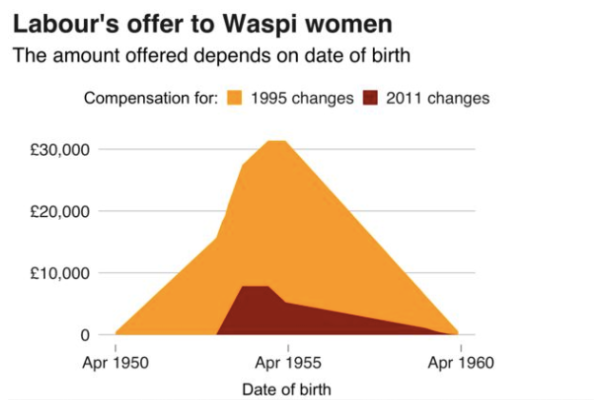WASPI Women to Get £3,150: Will WASPI women get £3,150 in compensation in 2025? That’s the million-pound question on the minds of millions of UK women born in the 1950s. After decades of service and planning to retire at 60, many were told—sometimes at the last minute—that they’d have to wait until 65 or 66 to collect their state pension. This article breaks down everything: the compensation rumors, government response, eligibility rules, and what to do next. Whether you’re personally affected or just trying to understand the buzz around the WASPI (Women Against State Pension Inequality) campaign, you’re in the right place.
WASPI Women to Get £3,150
So, are WASPI women getting £3,150 in 2025? Not yet — but the legal battle is heating up. The government has rejected the payout, but public pressure and legal challenges could turn the tide. If you’re affected, stay informed, document your history, and be ready if compensation becomes a reality. This isn’t just about pensions — it’s about justice, trust, and recognition of a generation of women who were blindsided by bureaucracy.

| Topic | Details |
|---|---|
| Claim | WASPI women could receive up to £3,150 in compensation |
| Ombudsman Recommendation | Between £1,000 and £2,950, based on how severely each woman was impacted |
| Eligibility | Women born between April 6, 1950 and April 5, 1960 |
| Current Status (as of 2025) | Government rejected payout in 2024; legal action underway in 2025 |
| Estimated Total Cost | Between £3.5 billion and £10.5 billion |
| Next Steps | Awaiting outcome of a judicial review or legal challenge |
| Watch Out | Rise in compensation scams and phishing attempts |
| Where to Stay Updated | WASPI Official Website and UK Government Pension Info |
What is the WASPI Campaign?
WASPI, short for Women Against State Pension Inequality, is a grassroots movement representing approximately 3.8 million women across the UK. These women were born in the 1950s and expected to retire at 60, as per the laws in place when they began working.
But then came changes through the 1995 and 2011 Pensions Acts, which gradually increased the pension age for women to 66—but without adequate notice or preparation. Many only found out within a year or two of turning 60 that they’d have to work several more years.
The campaign began in 2015, pushing for:
- Fair financial compensation
- Recognition of emotional and financial harm
- Accountability from the Department for Work and Pensions (DWP)

The Pension Age Controversy: What Went Wrong?
While the 1995 Act gave the legal foundation to increase the pension age, communication was the real failure.
According to a 2021 investigation by the Parliamentary and Health Service Ombudsman (PHSO), the DWP failed to properly inform women of these changes. This failure created a financial and emotional burden on a generation who had planned their futures around a different timeline.
Some women found out just months before they were due to retire. Others received no notification at all. This sudden shift led to:
- Lost job opportunities
- Increased debt
- Delayed retirement
- Emotional distress
Historical Timeline of the WASPI Campaign
Let’s walk through how we got to this point.
- 1995: Pension Act passed, raising women’s pension age from 60 to 65, with a gradual rollout.
- 2011: New legislation sped up the increase and eventually equalized the pension age to 66.
- 2015: WASPI campaign launched, highlighting the lack of adequate notification.
- 2021: PHSO finds DWP guilty of maladministration.
- 2023: PHSO recommends compensation between £1,000 and £2,950 based on injustice severity.
- 2024: Government rejects payout, citing cost and prior awareness.
- 2025: Legal action begins, with potential for a judicial review forcing compensation.
Ombudsman’s Recommendation: Why £3,150?
The Parliamentary and Health Service Ombudsman recommended a Level 4 injustice scale payout. This scale determines compensation based on the level of harm caused.
The figures:
- Level 3: £500–£950
- Level 4: £1,000–£2,950
- Level 5: £3,000–£9,950 (reserved for more severe cases)
Many campaigners are referencing £3,150 as the expected or fair amount, although the actual recommendation capped compensation at £2,950. This discrepancy often arises from media rounding or calls for a slightly more generous payout considering inflation and extended hardship.
Why Did the Government Say No?
In December 2024, the UK Government formally rejected the Ombudsman’s proposal. Their reasons included:
- Belief that most women had ample notice
- Fear of creating a precedent for other compensation claims
- A projected cost of up to £10.5 billion if all 3.8 million women were paid
Critics argue this response lacks empathy and ignores the real-world consequences experienced by these women. In Parliament, over 100 Labour MPs voiced dissent, and public opinion continues to lean in WASPI’s favor.

Legal Action in 2025: What Happens Now?
WASPI has taken the next step — issuing a “Letter Before Action” to the DWP, a legal notice that signals intent to file for a judicial review. This legal route may compel the government to:
- Reassess its decision
- Consider alternative payment methods
- Face judicial pressure to honor the Ombudsman’s findings
It’s now a waiting game. Legal proceedings may take several months or more, and any final outcome could be delayed until 2026 or later.
Who Qualifies for WASPI Compensation?
To qualify (if compensation is approved), a woman must:
- Have been born between April 6, 1950 and April 5, 1960
- Have expected to retire at 60 but had to wait longer
- Not have received timely, personalized communication from the DWP
Helpful documents include:
- Your birth certificate
- National Insurance records
- Any communication from the DWP
- Pension forecast statements from before and after age 60
Visual Breakdown: How Retirement Ages Shifted
| Birth Year | Original Retirement Age | New Pension Age | Years Delayed |
|---|---|---|---|
| 1952 | 60 | 64 | 4 |
| 1954 | 60 | 65 | 5 |
| 1956 | 60 | 66 | 6 |
This change affected not just finances, but life decisions, such as downsizing, caregiving, and retirement travel plans. Women from working-class backgrounds with no savings were hit the hardest.
Real-Life Impacts: Stories from the Ground
Lynda, 66, a retired nurse from Bristol:
“I was forced to take out a second mortgage. I’d planned to retire at 60. Instead, I worked until 65 while battling arthritis.”
Sandra, 63, a care assistant from Hull:
“I got no letter. I only found out when I applied for my pension. That shock sent me into depression for months.”
These stories are echoed by thousands of women across the UK, many of whom were juggling caring duties, health issues, or part-time work.
What You Can Do Now?
- Join the WASPI campaign
Sign up at waspi.co.uk to get campaign updates and legal notices. - Gather documentation
Prepare records that prove your eligibility in case a claims process opens. - Avoid scams
No official compensation claims are being processed. Never pay a fee or share personal info through unofficial channels. - Contact your MP
Make your voice heard. Ask them to support the WASPI cause in Parliament. - Follow trusted sources
Check sites like BBC News, The Guardian, and gov.uk for real updates.
WASPI Women Win Compensation in 2025—Here’s How to Make Sure You Get Paid
Massive £10,000 Compensation Deal for WASPI Women—Here’s What You Need to Know
DWP Issues Urgent Pension Alert for Brits Born Between These Dates – Are You Affected?











